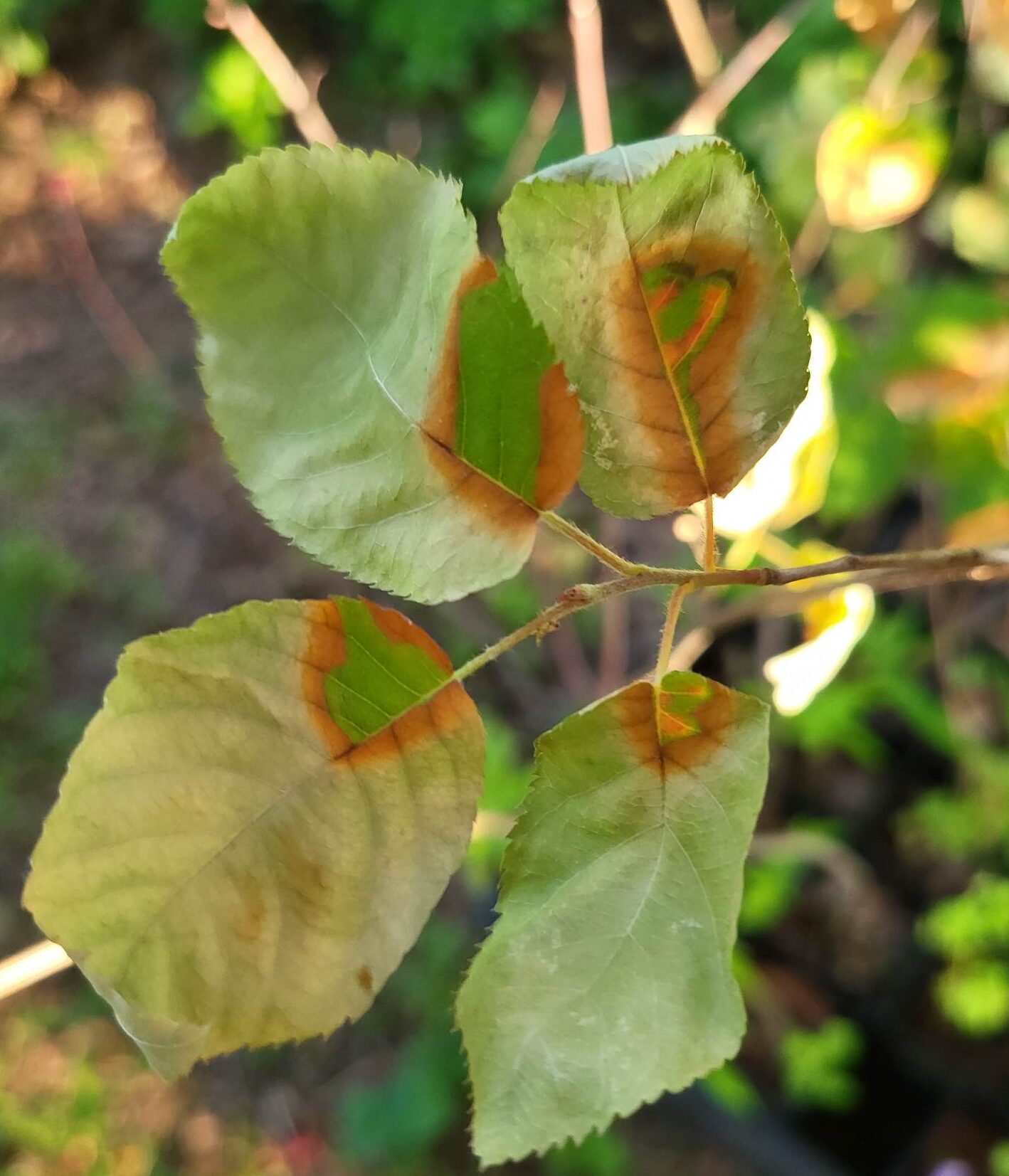It has been an unusually dry spring. In the past 60 days we’ve only had 8 days of rain, hardly invoking thoughts of “April showers.” The lack of rain has not only prematurely ended the spring 2023 growing season but has also left many trees, shrubs, and crops in danger.
Heat stress occurs when plants are exposed to excessively high temperatures or drought -like conditions for extended periods of time. This stress surpasses their optimal range for growth. To give context, most plants that we grow need even soil moisture, soil temperatures ranging from 80°-95° F, and air temperatures that fluctuate between 55° and 80°F. Just like any other living species, plants have their own limits and thresholds when it comes to tolerating heat. When these limits are exceeded, a slew of detrimental effects unfold.
One of the primary consequences of heat stress is increased water loss through evaporation. As temperatures soar, plants must transpire more water to cool themselves down. This will lead to dehydration and wilting. If the delicate balance between water uptake and loss is disrupted, the plant’s ability to maintain proper hydration will be strained. This not only affects their immediate survival but also impacts long-term growth and productivity.
Each species of plant may be affected by heat differently. Most of the plants that we grow for personal consumption (ie. corn, soybeans, pumpkin, squash, tomatoes, peppers, and fruit-bearing trees) are negatively affected by excessive heat. Some signs of heat related stress on plants include: leaf scorch, leaf rolling, wilting, blossom/fruit drop, sunscald, blossom end rot, and other variable conditions that could be brought on by secondary pathogens.
Heat stress adversely affects plant metabolism, disrupting their vital biochemical processes. High temperatures can impair photosynthesis—the process through which plants convert sunlight into energy. Reduced photosynthesis limits the plant’s ability to produce sugars and store energy, weakening their overall health.
Heat stress also leaves plants more vulnerable to pests, diseases, and infections. When plants are weakened by high temperatures, their natural defense mechanisms are compromised. This creates an open invitation for pests and pathogens to attack, leading to further damage and potential plant death.
As if the stress on the plants wasn’t enough, drought can also intensify flooding in a variety of ways. In drought-stricken areas, the dry soil acts like a hard, water repelling crust preventing rainwater from infiltrating into the ground. Instead, water accumulates on the surface leading to increased runoff. This runoff quickly gathers in drainage systems, streams, and rivers.
The lack of sufficient water hampers the growth and health of plants, resulting in reduced vegetation cover. This reduction in vegetation cover leaves the soil more exposed and vulnerable to erosion. This erosion not only carries away valuable soil nutrients but also creates channels and gullies that further facilitate the rapid flow of surface water.
It’s important to note that drought alone does not directly cause floods. Nor should it be said that we’re expecting flooding in the future. Instead, it sets the stage for more severe flooding when heavy rainfall finally occurs. The prolonged period of dryness creates conditions that reduce the soil’s ability to absorb water. Thereby increasing the potential for flooding when precipitation finally arrives.
So, what can we do to help plants with heat stress?
If you practice some of the measures below as suggested by the Oregon State Extension your plants have a better chance of surviving.
Proper Watering – While recommendations regarding the ideal timing of watering vary, deep watering is preferred over shallow watering. Morning watering is often prescribed in times of high heat, but wilted plants should be watered as soon as is reasonable to minimize the time spent in a wilted state.
Know your plants’ roots: Shallowly rooted plants will dry out more quickly and will wilt faster.
Tap-rooted plants can draw water from deeper into the soil.
Young plants with less root development will need water more often than older, established plants with a large network of roots for drawing moisture from the soil.
Mature trees can suffer from heat and drought stress just like smaller plants but may not show symptoms of that stress until much later.
Temporary Shading – Move containers where they get shade. Provide shade cloth or other means of shade, where possible. Heat stress is compounded when other plant stressors like drought, wind or intense sun are also present.
If using a shade device not typically used for gardening, like a beach or picnic umbrella, consider adding it in the late morning and removing it toward the end of the day so plants get some direct sunlight. Be prepared for plants that are heavily shaded for long periods to “stretch” toward more light.
Mulch – Mulch conserves moisture in the soil by slowing evaporation and minimizing temperature fluctuation in the soil. Shallowly rooted and young plants will be most impacted when the top few inches of soil are hot and dry.
Provide Humidity – In times of excessive heat and drought use the early morning to mist the leaves lightly to create dew. This is not recommended by some gardeners because under normal temperature ranges misting the leaves could open some plants up to pathogens and with the right situation increase the risk of diseases.
Don’t Plant or Transplant – As you know the best time to plant is in fall or spring. That’s because transplanting is stressful in itself, add soil that is too warm to the mix and it goes sour quickly. Some species can develop cankers on the stem where it meets the soil.
Don’t Prune – Removal of leaves and branches means a new part of the canopy will be exposed to sunlight. In times of intense heat, this can lead to sunburn in leaves that were previously shaded. Trees and shrubs with sunburn in a portion of the canopy will likely recover but will be unattractive in the meantime. Stressed trees are more likely to attract damaging insects like wood-boring beetles.
Don’t Apply Chemicals – Many treatments for plant disease and insect issues can damage plants when temperatures are consistently above 80°F. Check the label of a product for specifics before applying. Some plant types such as conifers and succulents can be further damaged by any treatment (even soap or neem oil) applied during extreme heat.
Hopefully, these tips will be helpful as we progress into summer. If you do see signs of stress, the quickest remedies would be to water more frequently, add bark mulch or standard wood chip mulch, and (if your plants are in pots) move them to a shadier spot. Keep checking on your plants and hope for rain! Good luck and happy planting!

